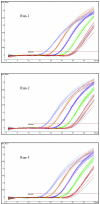Development and validation of a rotor-gene real-time PCR assay for detection, identification, and quantification of Chlamydia trachomatis in a single reaction
- PMID: 16390971
- PMCID: PMC1351959
- DOI: 10.1128/JCM.44.1.206-213.2006
Development and validation of a rotor-gene real-time PCR assay for detection, identification, and quantification of Chlamydia trachomatis in a single reaction
Abstract
A multitarget real-time PCR (MRT-PCR) for detection of Chlamydia trachomatis DNA was developed and validated. There were three targets for amplification in a single reaction: the cryptic plasmid (CP), the major outer membrane protein (MOMP) gene, and an internal control. The assay had the following characteristics: (i) detection and confirmation of the presence of C. trachomatis DNA in a single reaction, (ii) detection of all genovars of C. trachomatis without any cross-reactivity with pathogenic bacteria or commensal organisms of the oropharynx and genital tract, (iii) a 95% probability of detection with three copies of MOMP and one copy of CP per reaction mixture, (iv) identification of the inhibition of amplification, (v) a quantitative dynamic range of 25 to 250,000 genome copies per reaction mixture, (vi) high intra- and interassay reproducibilities, and (vii) correct identification of all samples in the validation panel. There were 146 COBAS Amplicor PCR (Amplicor PCR)-positive samples and 122 Amplicor PCR-negative samples in the panel. MRT-PCR detected CP DNA alone in 6 (4%) Amplicor PCR-positive samples and both CP and MOMP DNAs in 140 (96%) of 146 Amplicor PCR-positive samples. The quantity of MOMP DNA in 95 (68%) of 140 samples was within the dynamic range of the assay. The median C. trachomatis load in these samples was 321 genome copies per reaction mixture (range, 26 to 40,137 genome copies per reaction mixture). Due to the inclusion of two different C. trachomatis-specific targets, the assay confirmed 259 (97%) of 268 results in a single reaction. This assay could be used in the qualitative format for the routine detection of C. trachomatis and in the quantitative format for study of the pathogenesis of C. trachomatis-associated diseases. The assay demonstrated the potential to eliminate the need for confirmatory testing in almost all samples, thus reducing the turnaround time and the workload.
Figures



Similar articles
-
Development of a novel quantitative real-time assay using duplex scorpion primer for detection of Chlamydia trachomatis.Exp Mol Pathol. 2007 Aug;83(1):119-24. doi: 10.1016/j.yexmp.2006.11.005. Epub 2007 Jan 12. Exp Mol Pathol. 2007. PMID: 17222821
-
Validation of a laboratory-developed real-time PCR protocol for detection of Chlamydia trachomatis and Neisseria gonorrhoeae in urine.Sex Transm Infect. 2010 Jun;86(3):207-11. doi: 10.1136/sti.2009.040634. Sex Transm Infect. 2010. PMID: 20522633
-
Comparison of DNA extraction from cervical cells collected in PreservCyt solution for the amplification of Chlamydia trachomatis.Cytopathology. 2005 Apr;16(2):82-7. doi: 10.1111/j.1365-2303.2005.00239.x. Cytopathology. 2005. PMID: 15787650
-
Development of real-time PCR assays for genotyping of Chlamydia trachomatis.J Clin Microbiol. 2007 Aug;45(8):2649-53. doi: 10.1128/JCM.00451-07. Epub 2007 Jun 13. J Clin Microbiol. 2007. PMID: 17567790 Free PMC article.
-
Review of Chlamydia trachomatis viability methods: assessing the clinical diagnostic impact of NAAT positive results.Expert Rev Mol Diagn. 2018 Aug;18(8):739-747. doi: 10.1080/14737159.2018.1498785. Epub 2018 Jul 19. Expert Rev Mol Diagn. 2018. PMID: 29987959
Cited by
-
Mycoplasma genitalium infection is associated with microscopic signs of cervical inflammation in liquid cytology specimens.J Clin Microbiol. 2014 Jul;52(7):2398-405. doi: 10.1128/JCM.00159-14. Epub 2014 Apr 23. J Clin Microbiol. 2014. PMID: 24759719 Free PMC article.
-
Anorectal Chlamydia trachomatis Load Is Similar in Men Who Have Sex with Men and Women Reporting Anal Sex.PLoS One. 2015 Aug 11;10(8):e0134991. doi: 10.1371/journal.pone.0134991. eCollection 2015. PLoS One. 2015. PMID: 26262680 Free PMC article.
-
Viability-PCR Shows That NAAT Detects a High Proportion of DNA from Non-Viable Chlamydia trachomatis.PLoS One. 2016 Nov 3;11(11):e0165920. doi: 10.1371/journal.pone.0165920. eCollection 2016. PLoS One. 2016. PMID: 27812208 Free PMC article.
-
One-step pentaplex real-time polymerase chain reaction assay for detection of zika, dengue, chikungunya, West nile viruses and a human housekeeping gene.J Clin Virol. 2019 Nov;120:44-50. doi: 10.1016/j.jcv.2019.08.011. Epub 2019 Sep 16. J Clin Virol. 2019. PMID: 31557664 Free PMC article.
-
Molecular Detection of Coxiella burnetii in Ticks Isolated from Domestic Animals in Slaughterhouses and Farms, Shahr-E-Rey, Tehran, Iran.J Arthropod Borne Dis. 2024 Jun 30;18(2):149-156. doi: 10.18502/jad.v18i2.17538. eCollection 2024 Jun. J Arthropod Borne Dis. 2024. PMID: 39850262 Free PMC article.
References
-
- Aliyu, S. H., R. K. Marriott, M. D. Curran, S. Parmar, N. Bentley, N. M. Brown, J. S. Brazier, and H. Ludlam. 2004. Real-time PCR investigation into the importance of Fusobacterium necrophorum as a cause of acute pharyngitis in general practice. J. Med. Microbiol. 53:1029-1035. - PubMed
-
- An, Q., J. Liu, W. O'Brien, G. Radcliffe, D. Buxton, S. Popoff, W. King, M. Vera-Garcia, L. Lu, J. Shah, J. Klinger, and D. M. Olive. 1995. Comparison of characteristics of Qβ replicase-amplified assay with competitive PCR assay for Chlamydia trachomatis. J. Clin. Microbiol. 33:58-63. - PMC - PubMed
-
- Castriciano, S., K. Lunistra, D. Jang, J. Patel, J. Mahony, J. Kapala, and M. Chernesky. 2002. Accuracy of results obtained by performing a second ligase chain reaction assay and PCR analysis on urine samples with positive or near-cut-off results in the LCx test for Chlamydia trachomatis. J. Clin. Microbiol. 40:2632-2634. - PMC - PubMed
Publication types
MeSH terms
Substances
LinkOut - more resources
Full Text Sources
Other Literature Sources
Medical
Molecular Biology Databases
Miscellaneous

